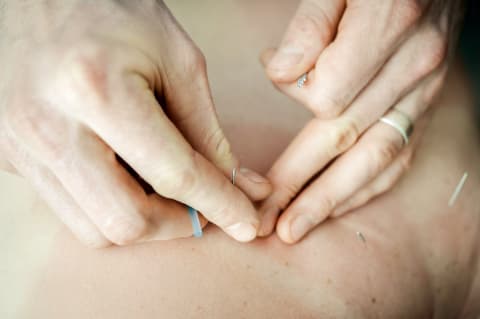Advertisement
Dry Needling: The Most Controversial (And The Most Effective) Therapy For Your Neck, Jaw & Back Pain



Have you ever heard of dry needling? If the answer is no, you're definitely not alone. Dry needling, also known as trigger-point dry needling, is a technique used to treat myofascial pain1—commonly in the neck and back—by inserting a thin needle directly into different areas of the muscle.
Dry needling: here's how it really works.
Basically, dry needling focuses on myofascial trigger points, or hypersensitive bands of muscle that cause limited range of motion and can refer pain to other areas of the body. In other words: trigger points are those hard, painful knots in your neck and back that seem to linger, causing stiffness and pain. The exact mechanism by which dry needling works is still unknown. The best theory at the moment is that the elimination of trigger points removes peripheral sensitization1, which occurs when your pain threshold is reduced in a particular area and the nerves become hyper-responsive as a result.
The goal of dry needling is to induce a spasm in the muscle, which releases the trigger point and allows the knot in the muscle to relax. Sound a little painful? It definitely can be. Poking needles in your muscles is no walk in the park, but dry needling can be very effective at targeting deeper areas that can’t reached by other manual therapies like massage. People swear by dry needling's ability to relax muscles and reduce pain in a way that can't seem to be achieved any other way.
Acupuncture vs. dry needling.
If you're thinking "this sounds a lot like acupuncture," again, you're not alone. Many people try to group them together. But dry needling is not acupuncture; it's a Western medical technique performed by a physician or physical therapist that just happens to involve thin acupuncture-like needles. It also might just be the therapy you've been waiting for for your chronic neck pain, back pain, or jaw pain.
The research on dry needling: Is it legit?
There is some research on dry needling, and it does seem to be effective at treating myofascial trigger points, especially when it's ultrasound guided. In one study, four sessions of dry needling were given to people with chronic neck pain over a period of two weeks. Dry needling was shown to reduce pain intensity, sensitivity to pain, and perceived neck disability while increasing range of motion and muscle strength in the short and long term.
Numerous other studies have confirmed its effectiveness at treating acute and chronic pain and shown it to be a relatively simple, noninvasive, and low-risk method (assuming it's done correctly and by someone well-trained). Knowing this, it's hard to understand why dry needling isn't very well-known.
According to Marvin Singh, a triple board-certified physician, "A recent study demonstrated that including dry needling into a rehabilitation program2 could decrease spasticity and improve balance and range of motion in those who have had a stroke." Therefore, while it seems that dry needling could potentially play a role in myofascial and other muscular pain syndromes, the quality of the studies that have been done is not great enough to draw any definitive conclusions.
Ultrasound dry needling vs. regular dry needling.
So now on to the most important question on your mind: How many times do you have to go before you see significant results? This depends on the type of pain you're experiencing and what type of dry needling you get. According to Lev Kalika, D.C., a chiropractic doctor who frequently performs dry needling on his patients—in fact, he trained with Karel Lewit, M.D., DSC, who was one of the first doctors to start doing dry needling on patients—“The average dry needling procedures statistically performed in the U.S. are around 12 to 15 sessions. With UGDN (Ultrasound Guided Dry Needling) this number goes down to two to three sessions. If effective, dry needling has immediate effect on pain, but the duration of the effect depends on the factors."
And on that note: Both Dr. Singh and Dr. Kalika recommend UGDN whenever possible. The potential risks are significantly reduced if you use an ultrasound as Dr. Kalika does in his practice at New York Dynamic Neuromuscular Rehabilitation and Physical Therapy.

Safety concerns surrounding dry needling.
Depending on the type of health care provider you ask, dry needling can be a contentious topic. And that is, in part, because of safety concerns surrounding it. So is dry needling dangerous? It can be, especially if it's done by someone who isn't trained properly. According to Dr. Singh, "There are case reports demonstrating complications such as spinal epidural hematoma3, pneumothorax4 (punctured lung), deep infection5, and radial nerve injury,6 among others." If you're interested in dry needling, it's important to understand the risks and weigh the pros and cons as you would with any other type of intervention, like medication or dietary changes. And even more importantly, make sure you find someone who is experienced in the technique.
So what should you look for in a dry needling practitioner besides that they use UGDN? Dr. Kalika says that you should look for a professional who has a dry needling certification and preferably other certifications in manual therapy methods—like myofascial release approach and joint mobilization certifications as well. According to Dr. Kalika, this is because having skill in palpation and examination of soft tissue is also necessary to have real success with dry needling. And that makes sense: You want someone who has an intricate knowledge of human anatomy and physiology to increase the chances that they'll be able to target the trigger points as efficiently as possible.
The final question: Is dry needling right for you?
For anyone suffering from muscle pain—in the neck, shoulders, back, or even the jaw—dry needling might be something to consider, especially if other therapies haven't done the trick. Dry needling is usually part of a larger action plan that includes stretching and muscle strengthening exercises to prevent those stubborn trigger points from returning. Treatments can be pricey and are not always covered by insurance, but dry needling is becoming increasingly popular as an effective, drug-free approach to relieving muscle pain that is definitely worth a second look.
So why, then, is it so controversial? Despite cost and safety concerns from going to a practitioner that isn't properly trained, dry needling is a symptom of the battle between conventional and alternative medicine techniques. Dr. Kalika had some important final thoughts on the controversy surrounding dry needling: "I think there are two reasons, 1) We cannot yet find the exact mechanism of action. 2) Dry needling is a time-consuming and not an easily learned skill. There is big resistance from the medical community because doctors and specialists look for quick, invasive, and more profitable solutions. There is also pushback on this procedure because no medicine is injected during the procedure, so there is no gain to the pharmaceutical industry either."
So is dry needling right for you? It's not without risks, and it's not for the faint of heart—since it can cause significant pain when the muscle is releasing—but if you have low-back pain, mid-back pain, neck pain, shoulder pain, sciatica, carpal tunnel, plantar fasciitis, or frequent headaches and hip pain that doesn't seem to be responding to other treatments, it's definitely worth considering.
Watch Next
Enjoy some of our favorite clips from classes
Enjoy some of our favorite clips from classes
What Is Meditation?
Mindfulness/Spirituality | Light Watkins
Box Breathing
Mindfulness/Spirituality | Gwen Dittmar
What Breathwork Can Address
Mindfulness/Spirituality | Gwen Dittmar
The 8 Limbs of Yoga - What is Asana?
Yoga | Caley Alyssa
Two Standing Postures to Open Up Tight Hips
Yoga | Caley Alyssa
How Plants Can Optimize Athletic Performance
Nutrition | Rich Roll
What to Eat Before a Workout
Nutrition | Rich Roll
How Ayurveda Helps Us Navigate Modern Life
Nutrition | Sahara Rose
Messages About Love & Relationships
Love & Relationships | Esther Perel
Love Languages
Love & Relationships | Esther Perel
What Is Meditation?
Box Breathing
What Breathwork Can Address
The 8 Limbs of Yoga - What is Asana?
Two Standing Postures to Open Up Tight Hips
How Plants Can Optimize Athletic Performance
What to Eat Before a Workout
How Ayurveda Helps Us Navigate Modern Life
Messages About Love & Relationships
Love Languages
Advertisement

8 Dietitians Share The Nutrition Advice They Actually Follow
Molly Knudsen, M.S., RDN

Why Women Are Twice As Likely To Struggle With Depression & Anxiety
Phyllis E. Greenberger, MSW

8 Dietitians Share The Nutrition Advice They Actually Follow
Molly Knudsen, M.S., RDN

Why Women Are Twice As Likely To Struggle With Depression & Anxiety
Phyllis E. Greenberger, MSW













